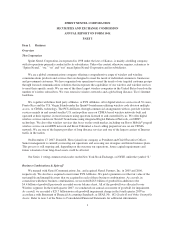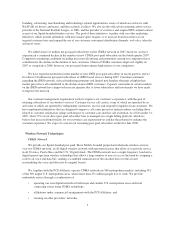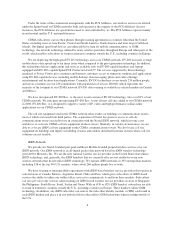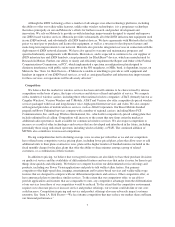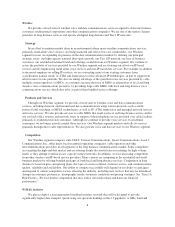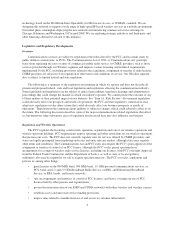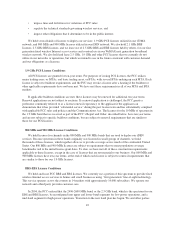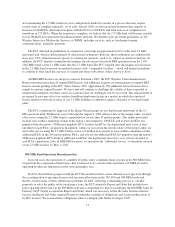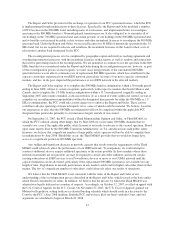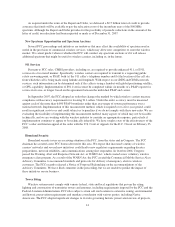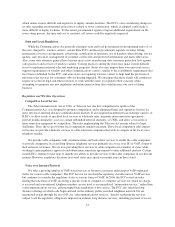Sprint - Nextel 2007 Annual Report Download - page 13
Download and view the complete annual report
Please find page 13 of the 2007 Sprint - Nextel annual report below. You can navigate through the pages in the report by either clicking on the pages listed below, or by using the keyword search tool below to find specific information within the annual report.are transitioning the 2.5 GHz band to its new configuration market-by-market in a process that may require
several years to complete nationally. As of early January 2008, we had served pre-transition data requests to
licensees in 264 BTAs, filed initiation plans with the FCC for 226 BTAs and filed notices of completion for
transitions in 175 BTAs. When the transition is complete, we believe that the 2.5 GHz band will be more suitable
for our WiMAX next generation broadband wireless network. We intend to provide fourth generation, or 4G,
Wireless Interactive Multimedia Services, or WIMS, and other services, such as fixed point-to-point
communications, using this spectrum.
The FCC affirmed its prohibition of commercial ownership on approximately 62% of the total 2.5 GHz
spectrum band, which is held primarily by educational institutions; however, these institutions are authorized to
lease up to 95% of their licensed capacity to commercial operators, such as us, subject to certain restrictions. In
addition, the FCC adopted a band plan that requires the relocation of licensed BRS operations from the 2150-
2162 MHz band, or the 2.1 GHz band, into the 2.5 GHz band. The FCC adopted rules that require new licensees
in the 2.1 GHz band to provide incumbent licensees with “comparable facilities,” which will permit incumbents
to continue to offer fixed data services to current and future subscribers if they choose to do so.
All BRS-EBS licenses are subject to renewal. In January 2007, the FCC Wireless Telecommunications
Bureau reinstated more than 50 expired EBS licenses and additional requests for reinstatement of expired EBS
licenses remain pending at the FCC. Since January 2007, approximately 150 additional former licensees have
sought to reinstate expired licenses. We have and will continue to challenge the validity of these requested or
adopted reinstatements, but there can be no assurance that our challenges will be successful. The reinstatement of
an expired license may affect our wireless broadband deployment plans in a market in which the reinstated
license interferes with one or more of our 2.5 GHz holdings or otherwise requires alteration of our deployment
plans.
The FCC conditioned its approval of the Sprint-Nextel merger on two deployment milestones in the 2.5
GHz spectrum band. Within four years following the August 8, 2005 effective date of the merger order, we must
offer service using the 2.5 GHz band to a population of no less than 15 million people. This deployment must
include areas within a minimum of nine of the nation’s most populous 100 BTAs and at least one BTA less
populous than the nation’s 200th most populous BTA. In these ten BTAs, the deployment must cover at least
one-third of each BTA’s population. In addition, within six years from the effective date of the merger order, we
must offer service using the 2.5 GHz band to at least 15 million more people in areas within a minimum of nine
additional BTAs in the 100 most populous BTAs, and at least one additional BTA less populous than the nation’s
200th most populous BTA. In these additional ten BTAs, the deployment must also cover at least one-third of
each BTA’s population. Like all BRS-EBS licensees, we must provide “substantial service” to the public on each
of our 2.5 GHz licenses by May 1, 2011.
800 MHz Band Spectrum Reconfiguration
In recent years, the operations of a number of public safety communications systems in the 800 MHz block
of spectrum have experienced interference that is believed to be a result of the operations of CMRS providers
operating on adjacent frequencies in the same geographic area.
In 2001, Nextel filed a proposal with the FCC that would result in a more efficient use of spectrum through
the reconfiguration of spectrum licenses and spectrum allocations in the 700, 800 and 900 MHz bands and,
thereby, resolve many of these interference problems. In 2004, following a rulemaking process to consider
proposals to solve the public safety interference issue, the FCC adopted a Report and Order that included new
rules regarding interference in the 800 MHz band and a comprehensive plan to reconfigure the 800 MHz band. In
February 2005, Nextel accepted the Report and Order, which was necessary before the order became effective,
because the Report and Order required Nextel to undertake a number of obligations and accept modifications to
its FCC licenses. We assumed these obligations when we merged with Nextel in August 2005.
11


